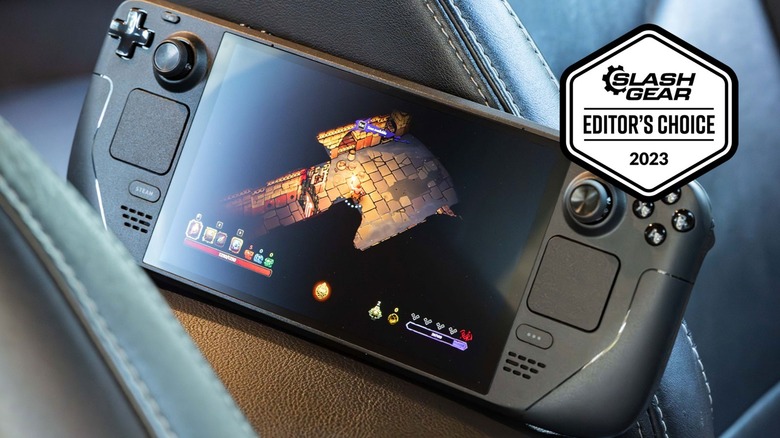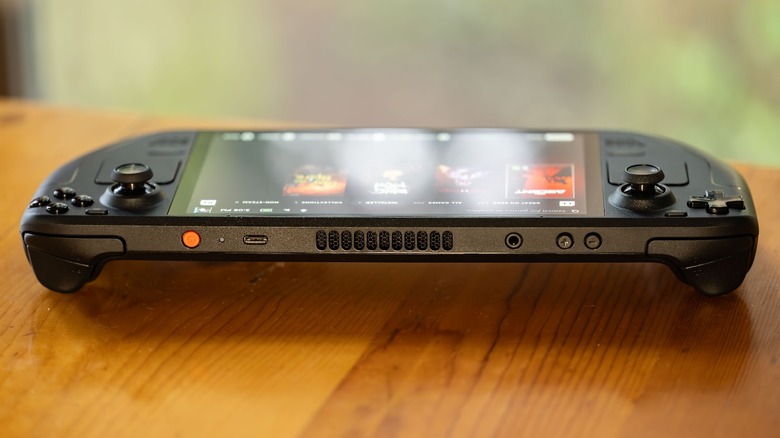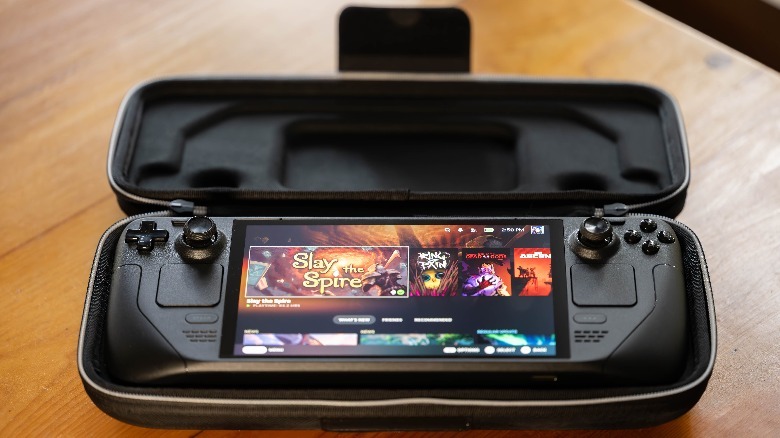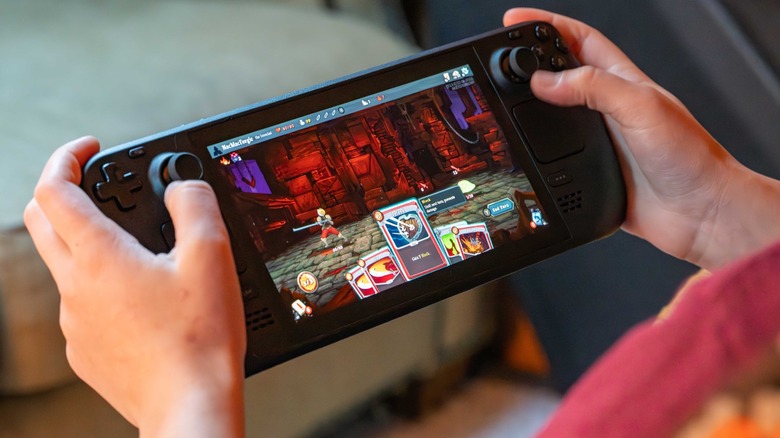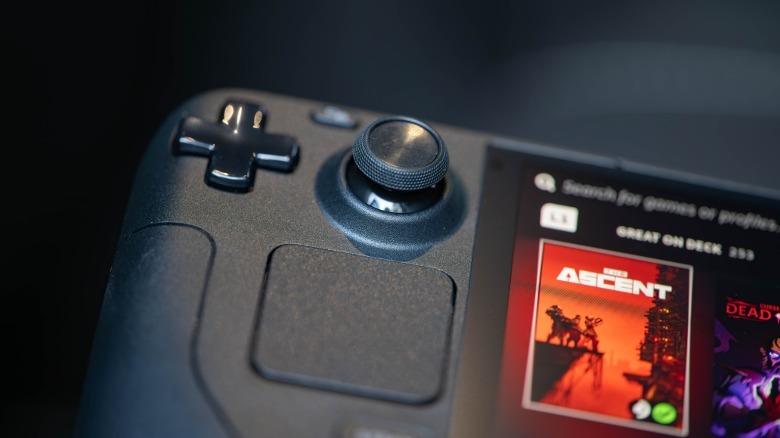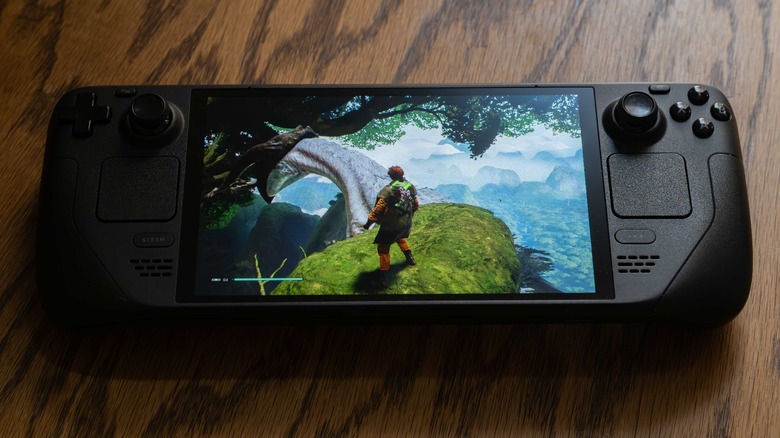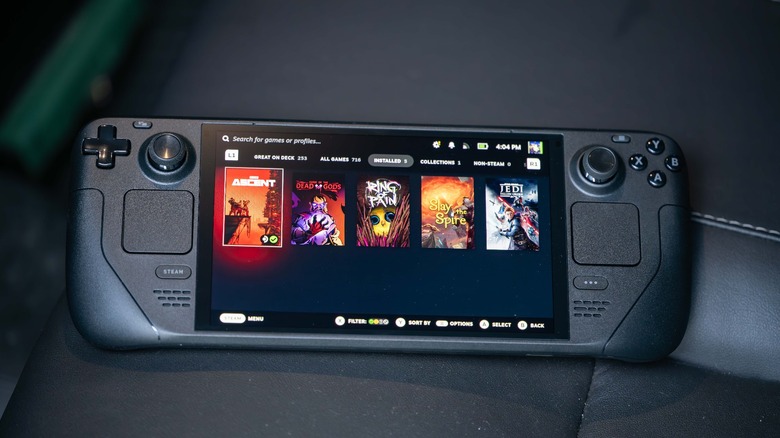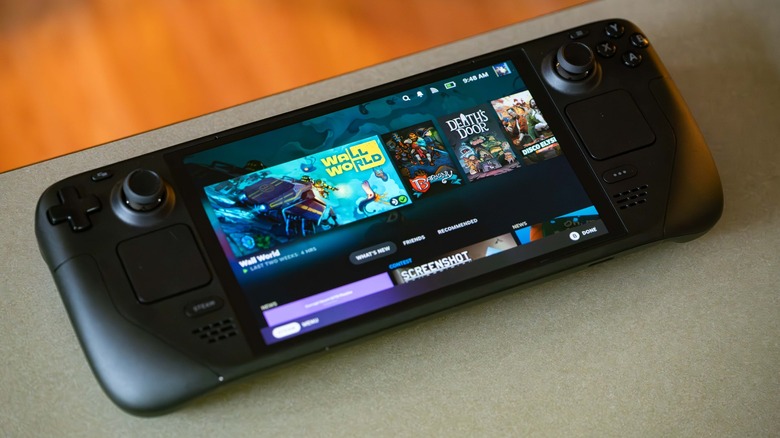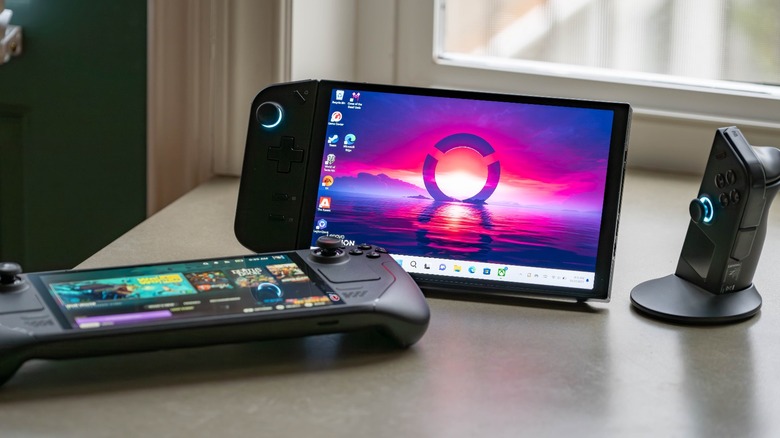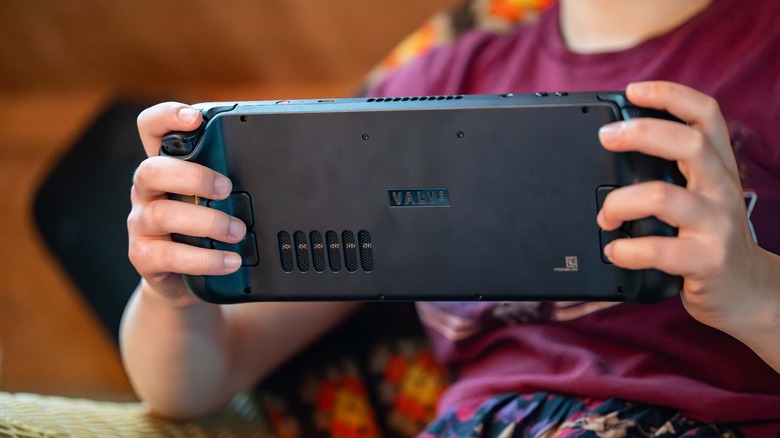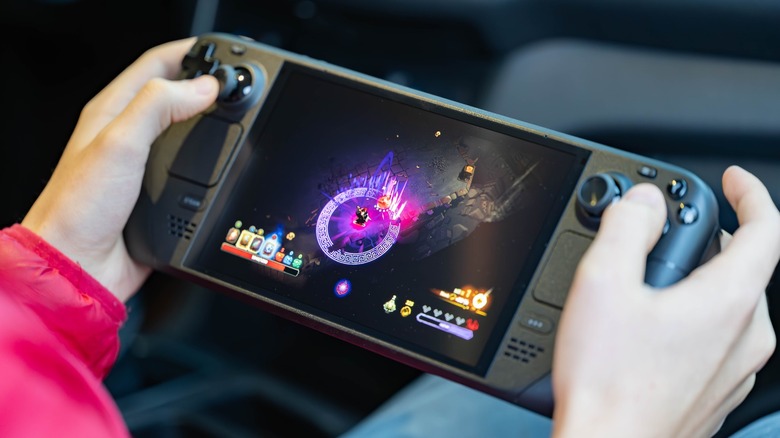Steam Deck OLED Review: Worth The Weight
- Much-improved OLED display
- Larger display doesn’t add bulk
- 90hz refresh rate
- Decreased weight is surprisingly noticeable
- Comfortable to use for long periods of time
- SteamOS provides a console-like experience
- Steam Deck Verified program lets you know which games work
- Installing non-steam games is still a pain
- No improvement in processing/graphics performance
- Only one USB-C port
The Valve Steam Deck OLED is the mid-generation update to the original Steam Deck, a device that was so influential that it essentially created a whole new category of portable computing devices overnight. While the Steam Deck OLED isn't a full-blown sequel, it's nonetheless an important update, particularly considering the more crowded market of compelling handheld gaming devices it must now compete against.
While the clue is in the name of the Steam Deck OLED as to what its most prominent upgrade is, there are plenty of other little tweaks under the hood to differentiate itself from the previous model. The older Steam Deck is widely acclaimed and much loved by its many users, so the question now becomes whether or not all those small changes to the OLED version represent a significant improvement. Is this merely a good option for those who don't yet have their own Steam Deck, or is there enough here to attract existing Deck owners to upgrade?
Valve provided a Steam Deck OLED for the purposes of this review.
Nearly identical appearance
The Steam Deck OLED is very similar to the original Steam Deck in appearance, but there are several key differences to take note of. The notation on the buttons is not as bright as before, and the base of the thumbsticks is now black rather than white. More importantly, the screen is now larger, but rather than increasing the size of the Steam Deck OLED, Valve merely shrunk the bezel around the display.
For ports, we still only get a single USB-C Type-C port and a 3.5mm headphone jack. This is perfectly adequate, but going back to having only one after using the Lenovo Legion Go, which has two USB-C ports, makes us miss the convenience of being able to plug in the dongle for our Razer Barracuda wireless headset into one port, and power cable into the other, or just being able to choose whether to power the device from the bottom or the top.
A wall charger is included with the Steam Deck, as well as a microfiber cloth and protective case. The case now features a velcro latch for additional safety and is also differentiated by the handle being located on the hinge side, and by the logo featuring a red dot instead of blue.
Light weight improves upon an already comfortable device
Functionally, buttons, touchpads, thumbsticks, bumpers, and triggers are all as before, which is a good thing considering how superb the design of the original Steam Deck was. The new OLED version fits similarly well in the hand, and we found that it can be used for hours of uninterrupted gameplay without discomfort. We had no problem reaching all of the controls, and the grips of the device contoured nicely to our hands. It's important to note that our primary tester has very large hands, so your experience may vary.
The other big change is weight; the new Steam Deck OLED is now lighter than its predecessor. While the difference doesn't look significant on paper, it was immediately apparent to us the first time we picked it up. This has improved overall comfort to a remarkable degree, despite the device retaining the same form factor and controls as its predecessor. The Steam Deck OLED is 5% lighter than the original. Not only was the light weight of this device the first thing we noticed, but the advantages of this became even more apparent after long use. Fatigue is significantly less of a concern than with the original Steam Deck.
New Deck, same performance
One area where the OLED version is on even footing with the original is in terms of its performance. Valve made the decision to maintain gaming performance parity between the first Steam Deck and this new, upgraded version. What changes have been made to its core components have been done in the name of efficiency, while carefully neither increasing nor decreasing its gaming prowess.
We enjoyed the same excellent gameplay experience in "Star Wars Jedi: Fallen Order" as we did on the original Steam Deck, as well as our perennial favorites such as "Slay the Spire," "Curse of the Dead Gods," and "The Ascent." All performed just as well on the Steam Deck OLED as they did on its predecessor. However, thanks to the faster 90Hz refresh rate of its display, the overall feeling was of a performance boost, at least in games where the Deck was able to push frame rates over 60fps.
Another key upgrade in the Steam Deck OLED comes in the form of support for Wi-Fi 6e, which should be particularly useful if your home Wi-Fi is up to date and you have a really fast broadband connection. We certainly found it to be fast and reliable in connecting to different Wi-Fi networks.
The joy of an OLED HDR display
We never found a reason to complain about the screen implemented in the original Steam Deck — even though the tech was very pedestrian, it got the job done. However, after using the OLED version for the past few weeks, the old one no longer seems as acceptable.
This touchscreen OLED display grants you those spectacular deep blacks you expect from such monitors, as well as bright and extremely accurate colors. It covers 110% of the DCI-P3 color gamut and can hit up to 1000 nits of peak brightness in HDR-compatible games. The 90Hz refresh rate (boosted from 60Hz in the original Deck) provides a much smoother user experience overall, both in and out of games.
While resolution has remained the same, still holding steady at 1280 x 800 despite the larger 7.4-inch display, we found no reason to complain about it. On as small a screen as this,1280 x 800 is plenty, particularly considering the limitations in terms of processing power inherent in the system. Even if it possessed a higher resolution display, you'd likely end up reducing the resolution in the settings to improve gameplay performance.
Cooler, quieter, with plenty of juice
The new 6nm AMD APU may not deliver more frames per second, but it does certainly help when it comes to taming the power consumption of the Steam Deck OLED. The 50-watt-hour battery is rated to provide 3-12 hours of gameplay, which we found to be an accurate assessment. We fired up "Wall World" for the first time one evening, and having been sucked into its addictive roguelike gameplay loop, later found that we had spent several hours playing, yet we still had plenty of battery left to spare. Of course, your experience may vary based on what you play.
Valve has also improved the cooling system in the Steam Deck OLED, and what they've achieved is no mean feat. The highest temperature we measured was a mere 97.7 degrees Fahrenheit (36.5 degrees Celsius), with most of the device remaining significantly cooler. Surprisingly, the Steam Deck OLED doesn't get any louder to achieve these low temperatures — in fact, it's much quieter than the original. Even in a quiet room, the disturbance caused by its fans running during a game is not particularly noticeable.
The looming threat of OLED burn-in and joystick drift
It's important to note that with an OLED panel comes the looming danger of burn-in. We didn't experience it at all, and Valve seems confident in it, but it's just something to keep in mind, particularly as the screen stays on by default while you're downloading games. You can dim the screen, or go into desktop mode and change the behavior of the display so that it turns off when the device is inactive. We just wish there was an option to make this adjustment within the easily available quick settings menu.
The other potential point of failure which may concern you is "joystick drift", which has been the boogeyman of the Nintendo Switch for many years. The Steam Deck OLED uses the same thumbsticks as the original Steam Deck, and fortunately, we haven't experienced any drifting issues with them over the years. While Hall Effect joysticks would be even more secure from drift, they have their own issues, which is why Valve decided to stick with the tried and tested analog sticks they've been using.
Of course, while neither of these potential stumbling blocks has yet to rear their ugly heads with the Steam Deck OLED, they are both issues that will only become apparent after a lot of people have spent a lot of time with the Steam Deck.
SteamOS is awesome, though not a perfect Windows replacement
Other handheld gaming systems just use Windows 11 with some additional software to try to smooth the rough edges of using Windows on a handheld. This works to some extent, but the truth is that Windows is not an operating system that plays well with a controller and touchscreen layout. Valve's solution to this problem was to build SteamOS, a platform based on Linux, which provides you with the sort of smooth, streamlined interface such as you'd expect to find on an Xbox, PlayStation, or Nintendo Switch.
So long as you stay within Steam's own storefront and software ecosystem, the result is by far the best experience on a handheld gaming device. The device boots up almost instantly, and you're immediately able to launch a game without having to deal with any hassle. It's the painless, seamless experience you expect from a game console. Despite running Linux, a compatibility layer allows the Steam Deck to play most games made for Windows.
The one fly in the ointment here is that if you want to install a game from outside of Steam, or an alternative game launcher/store such as Epic Games, Humble App, or GOG Galaxy, then you'll need to go through a somewhat convoluted process. This is understandable, given that Valve wants you to use the Steam store; the whole experience is tailored around playing games from Steam.
Steam Deck OLED vs Lenovo Legion Go and Nintendo Switch OLED
We're really spoiled for choice when it comes to gaming on the go, and while we certainly prefer the Steam Deck OLED over others that we have tested, it's worth taking a look at a few other options.
The Lenovo Legion Go is a good option if you're looking for a Windows 11 system. It's a more powerful and innovative device with detachable controllers, one of which converts into a mouse-like device. This makes it a better choice for playing FPS titles, though it takes a lot of practice to build up the necessary muscle memory. The big downside here is that the Legion Go has absolutely atrocious battery life, which is a serious Achilles heel in a mobile gaming device.
You might also like to consider the Nintendo Switch OLED as an alternative to the Steam Deck OLED, and it's certainly great if you want to play Nintendo games. However, it's a system that's really long in the tooth, and starting to show its age. You'll find a far wider selection of titles for less money on the Steam Deck, so unless you absolutely need to play first-party Nintendo games, the Steam Deck OLED is the easy device to pick out of the two.
Attractively priced
Steam currently sells three versions of the Steam Deck in their online store – two of the new OLED versions, and the old 256Gb model of the original Steam Deck, which is still available as the cheapest Steam Deck at $399. The Steam Deck OLED starts at $549 for the 512GB version, while the 1TB model we tested goes for $649. The one difference between the two aside from storage is that the 1TB model has an improved anti-glare etched glass screen.
As when the original Steam Deck was released, the new OLED deck is something of a bargain. We'd definitely recommend spending the extra $100 on the 1TB version given how large games have become in recent years. However, if you'd rather save some money now and upgrade later, it is possible to swap out the SSD for a larger one down the road, as long as you're comfortable disassembling the device and working with somewhat delicate internal electronics.
Conclusion
If you're looking for a handheld gaming system, then you really can't do better than the Steam Deck OLED. It may have competitors with more resolution, more powerful processors, and innovative ideas, but there's a reason the original Steam Deck made a big splash. The Steam Deck OLED improves upon the original in many ways, and while that gorgeous HDR OLED display is obviously the star of this show, the many tweaks and upgrades Valve has made under the hood add up to create a really impressive device.
We also appreciate Valve's care not to create a performance divide between different versions of the Steam Deck. This means that the entry of the new OLED version into the market will only bolster its player base, with the result being that more game developers will optimize their games for this hardware. Also, they've made it clear that a full-blown sequel is a long way off, so you don't need to hold off out of fear of a better one being right around the corner.
If you don't have a Steam Deck yet, then the OLED version is the obvious one to choose. Whether existing owners should upgrade is a more difficult decision, as the original decks are still great devices. However, the new model is good enough to make such an upgrade tempting, and overall we can highly recommend the Steam Deck OLED.
